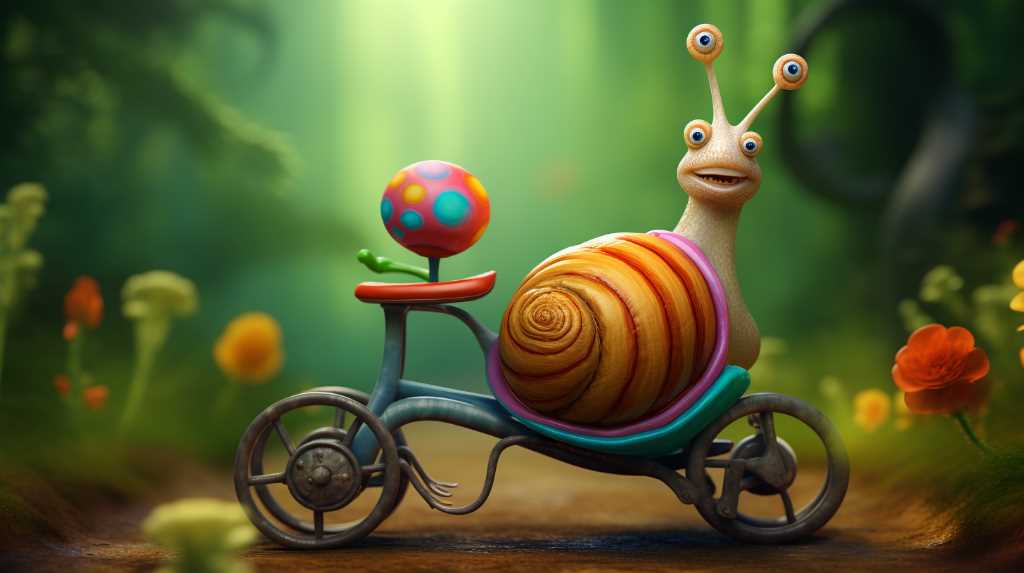Are you tired of the same old tricks and pet training routines? Well, get ready to have your mind blown because we have the ultimate challenge for you: training a snail to ride a bike.
Yes, you heard that right - a snail, on a bike. Now, you might be thinking, 'Is that even possible?' And the answer is, yes, it is! But before you dismiss this idea as pure nonsense, let us explain the fascinating world of snail training and how you can be a part of it.
So, buckle up (or should I say, strap on your helmets) because this journey is about to take you to places you never thought possible.
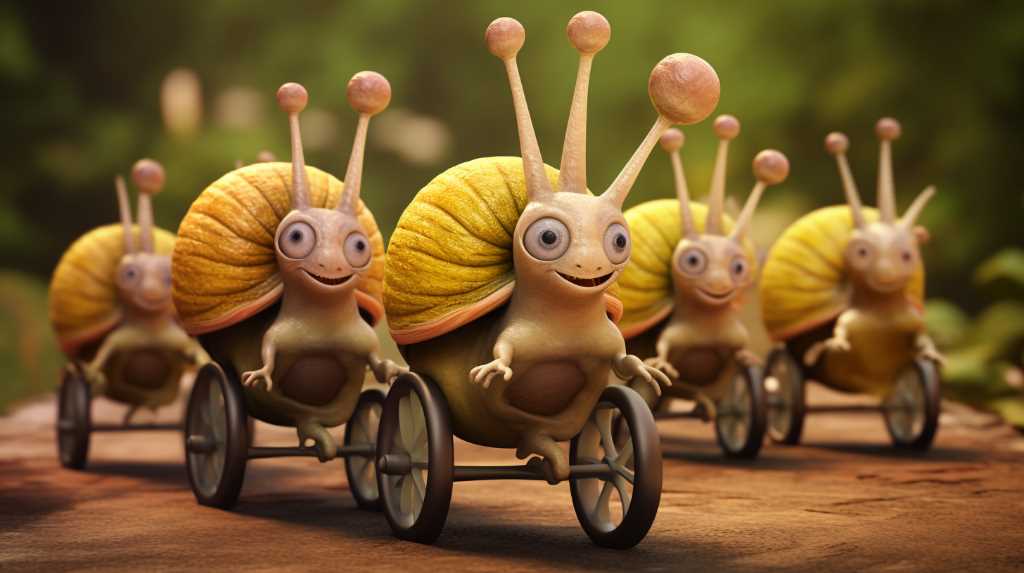 When selecting snails for training to ride a bike, it's important to consider their physical abilities and temperament.
First and foremost, you need to choose snails that are healthy and have a strong shell. Snails with weak shells may not be able to withstand the pressure and movements required for bike riding. Also, you should look for snails that have a good sense of balance. Snails with a natural ability to maintain balance are more likely to succeed in learning how to ride a bike.
Furthermore, the temperament of the snail is crucial. You want to select snails that are curious and willing to learn. Snails that are too timid or easily frightened may not be receptive to the training process. On the other hand, snails that are bold and adventurous will be more open to new experiences and challenges.
And lastly, it's important to choose snails of the appropriate size. Snails that are too small may not have the strength and stability to ride a bike effectively. On the contrary, snails that are too large may find it difficult to maneuver and balance on the bike.
When selecting snails for training to ride a bike, it's important to consider their physical abilities and temperament.
First and foremost, you need to choose snails that are healthy and have a strong shell. Snails with weak shells may not be able to withstand the pressure and movements required for bike riding. Also, you should look for snails that have a good sense of balance. Snails with a natural ability to maintain balance are more likely to succeed in learning how to ride a bike.
Furthermore, the temperament of the snail is crucial. You want to select snails that are curious and willing to learn. Snails that are too timid or easily frightened may not be receptive to the training process. On the other hand, snails that are bold and adventurous will be more open to new experiences and challenges.
And lastly, it's important to choose snails of the appropriate size. Snails that are too small may not have the strength and stability to ride a bike effectively. On the contrary, snails that are too large may find it difficult to maneuver and balance on the bike.
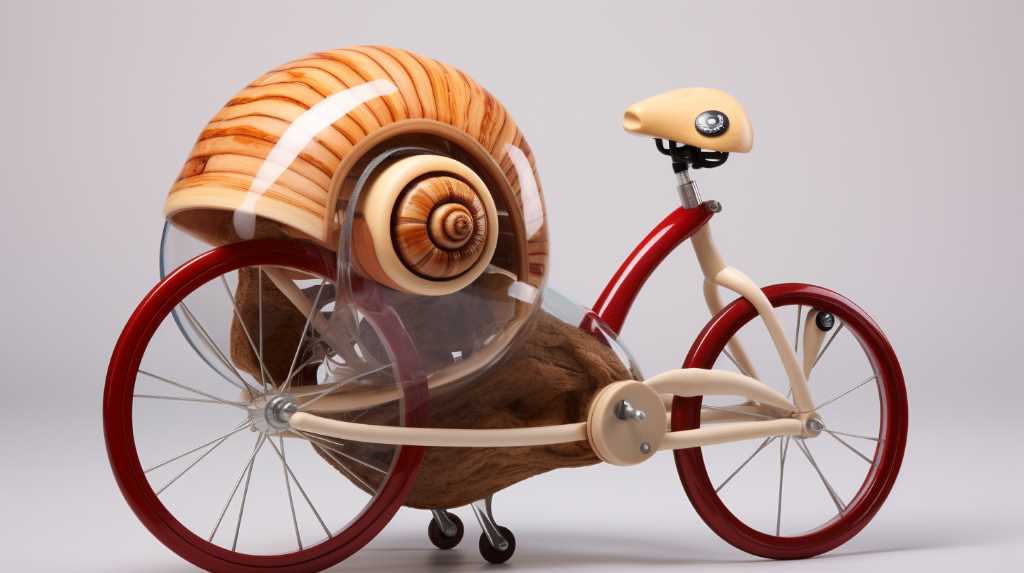 Now that you have selected the appropriate snails for training, it's time to prepare the bike for their learning journey. The first step is to ensure that the bike is in good working condition. Check the tires for any signs of wear and tear, and make sure they're properly inflated. A well-maintained bike with good tires is crucial for a smooth and safe ride for your snails.
Next, adjust the seat height to a comfortable level. Snails have delicate bodies, so it's important to provide them with a stable and balanced seating position. This will help them maintain their balance while riding. Additionally, ensure that the handlebars are securely tightened and positioned correctly. Snails have a small reach, so adjusting the handlebars to a suitable height will make it easier for them to grip and steer.
Now that you have selected the appropriate snails for training, it's time to prepare the bike for their learning journey. The first step is to ensure that the bike is in good working condition. Check the tires for any signs of wear and tear, and make sure they're properly inflated. A well-maintained bike with good tires is crucial for a smooth and safe ride for your snails.
Next, adjust the seat height to a comfortable level. Snails have delicate bodies, so it's important to provide them with a stable and balanced seating position. This will help them maintain their balance while riding. Additionally, ensure that the handlebars are securely tightened and positioned correctly. Snails have a small reach, so adjusting the handlebars to a suitable height will make it easier for them to grip and steer.
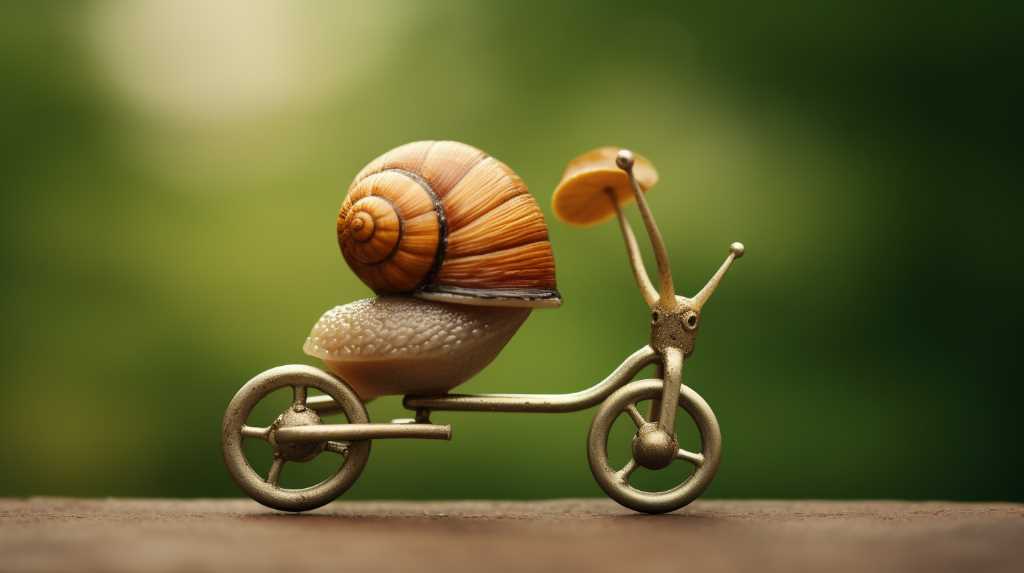 To begin the process of training your snails to ride a bike, you'll need to focus on mastering some basic training techniques. These techniques will help you establish a foundation of trust and communication with your snail, making the training process smoother and more effective.
The first technique is positive reinforcement. Snails respond well to rewards, so whenever your snail shows progress or follows a command, reward it with a treat or praise. This will motivate your snail to continue learning and performing the desired behaviors.
Next, consistency is key. Snails thrive in a structured environment, so establish a regular training routine and stick to it. This will help your snail understand what's expected of it and reinforce the training lessons.
Patience is crucial when training snails, we cannot stress this enough. They're slow creatures and may take longer to learn compared to other animals. Be patient and understanding, and avoid rushing or getting frustrated with your snail.
And lastly, break down the training tasks into small, manageable steps. Snails learn best when tasks are broken down into simpler actions. Start with basic commands like 'stop' and 'go,' and gradually introduce more complex commands as your snail becomes more comfortable.
To begin the process of training your snails to ride a bike, you'll need to focus on mastering some basic training techniques. These techniques will help you establish a foundation of trust and communication with your snail, making the training process smoother and more effective.
The first technique is positive reinforcement. Snails respond well to rewards, so whenever your snail shows progress or follows a command, reward it with a treat or praise. This will motivate your snail to continue learning and performing the desired behaviors.
Next, consistency is key. Snails thrive in a structured environment, so establish a regular training routine and stick to it. This will help your snail understand what's expected of it and reinforce the training lessons.
Patience is crucial when training snails, we cannot stress this enough. They're slow creatures and may take longer to learn compared to other animals. Be patient and understanding, and avoid rushing or getting frustrated with your snail.
And lastly, break down the training tasks into small, manageable steps. Snails learn best when tasks are broken down into simpler actions. Start with basic commands like 'stop' and 'go,' and gradually introduce more complex commands as your snail becomes more comfortable.
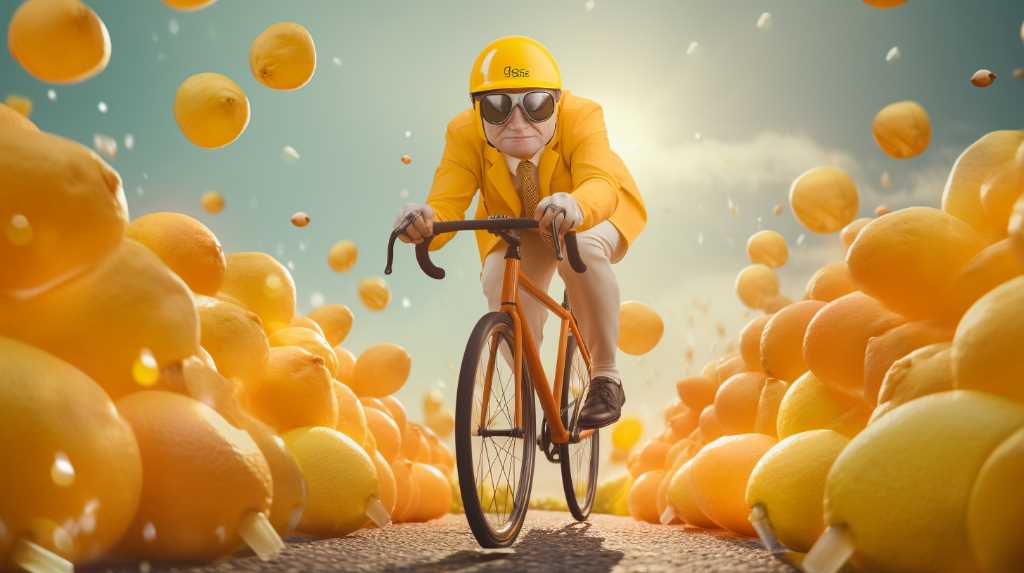 To enhance your snail's training abilities, incorporate advanced strategies that build upon the foundation of basic training techniques. As your snail progresses in its training, it's essential to challenge and stimulate its mind and body.
One advanced strategy is to introduce obstacle courses. Set up a course with small hurdles and ramps for your snail to navigate. Start with low obstacles and gradually increase the difficulty level as your snail becomes more proficient. This will help improve its coordination and balance.
Another strategy is to incorporate timed training sessions. Set a specific time limit for your snail to complete a task, such as riding a short distance on the bike. By adding time constraints, you encourage your snail to focus and perform tasks more efficiently. Be sure to reward your snail for completing the task within the allotted time.
You should also consider using positive reinforcement techniques, such as clicker training. Train your snail to associate a clicking sound with a reward, like a tasty treat. Use the clicker to mark desired behaviors and immediately provide a reward. This method helps your snail understand which actions are desirable and encourages it to repeat those behaviors.
Lastly, incorporate variety into your snail's training routine. Introduce new challenges, change the training environment, and even try training at different times of the day. This will keep your snail engaged and prevent boredom.
To enhance your snail's training abilities, incorporate advanced strategies that build upon the foundation of basic training techniques. As your snail progresses in its training, it's essential to challenge and stimulate its mind and body.
One advanced strategy is to introduce obstacle courses. Set up a course with small hurdles and ramps for your snail to navigate. Start with low obstacles and gradually increase the difficulty level as your snail becomes more proficient. This will help improve its coordination and balance.
Another strategy is to incorporate timed training sessions. Set a specific time limit for your snail to complete a task, such as riding a short distance on the bike. By adding time constraints, you encourage your snail to focus and perform tasks more efficiently. Be sure to reward your snail for completing the task within the allotted time.
You should also consider using positive reinforcement techniques, such as clicker training. Train your snail to associate a clicking sound with a reward, like a tasty treat. Use the clicker to mark desired behaviors and immediately provide a reward. This method helps your snail understand which actions are desirable and encourages it to repeat those behaviors.
Lastly, incorporate variety into your snail's training routine. Introduce new challenges, change the training environment, and even try training at different times of the day. This will keep your snail engaged and prevent boredom.
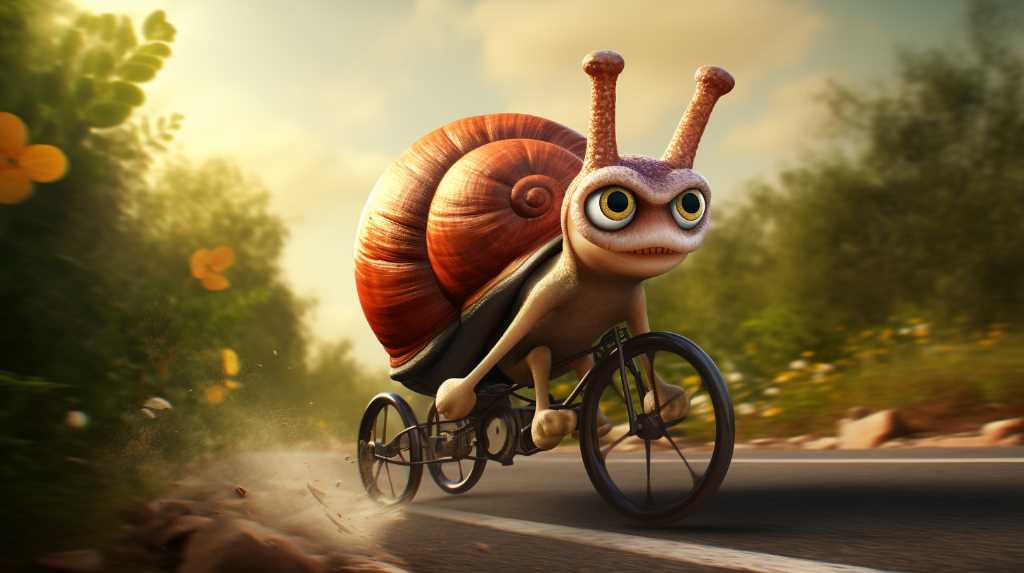 Overcoming challenges is an essential part of training your snail to ride a bike, but celebrating their successes is equally important. As you embark on this journey, you'll encounter various obstacles that may test your patience and determination. Your snail might struggle with balance, coordination, or even motivation. However, it's crucial to remember that progress takes time and perseverance.
When faced with challenges, it's important to approach them with a positive mindset. Break down the task into smaller, manageable steps. For example, if your snail is having difficulty with balance, start by placing it on a stationary bike and gradually introduce movement. Be patient and provide encouragement along the way. Remember, every small achievement is a step towards success.
Once your snail starts showing progress, it's essential to celebrate their successes. Positive reinforcement plays a vital role in training. Praise your snail with gentle words and even a small treat. This won't only boost their confidence but also reinforce the behavior you want to encourage.
Additionally, sharing their accomplishments with others can be a great way to celebrate. Document their journey through photos or videos and share them with friends and family. Their support and encouragement will further motivate both you and your snail.
Overcoming challenges is an essential part of training your snail to ride a bike, but celebrating their successes is equally important. As you embark on this journey, you'll encounter various obstacles that may test your patience and determination. Your snail might struggle with balance, coordination, or even motivation. However, it's crucial to remember that progress takes time and perseverance.
When faced with challenges, it's important to approach them with a positive mindset. Break down the task into smaller, manageable steps. For example, if your snail is having difficulty with balance, start by placing it on a stationary bike and gradually introduce movement. Be patient and provide encouragement along the way. Remember, every small achievement is a step towards success.
Once your snail starts showing progress, it's essential to celebrate their successes. Positive reinforcement plays a vital role in training. Praise your snail with gentle words and even a small treat. This won't only boost their confidence but also reinforce the behavior you want to encourage.
Additionally, sharing their accomplishments with others can be a great way to celebrate. Document their journey through photos or videos and share them with friends and family. Their support and encouragement will further motivate both you and your snail.
Key Takeaways
- Choose snails with healthy and strong shells, good sense of balance, and a curious and willing to learn temperament.
- Ensure the bike is in good working condition, with properly adjusted seat height and handlebars for a stable and balanced seating position.
- Use positive reinforcement, establish a regular training routine, and break down training tasks into small steps to effectively train the snail.
- Incorporate advanced training strategies such as obstacle courses, timed training sessions, clicker training, and variety to challenge and stimulate the snail's mind and body.
Snail Selection
 When selecting snails for training to ride a bike, it's important to consider their physical abilities and temperament.
First and foremost, you need to choose snails that are healthy and have a strong shell. Snails with weak shells may not be able to withstand the pressure and movements required for bike riding. Also, you should look for snails that have a good sense of balance. Snails with a natural ability to maintain balance are more likely to succeed in learning how to ride a bike.
Furthermore, the temperament of the snail is crucial. You want to select snails that are curious and willing to learn. Snails that are too timid or easily frightened may not be receptive to the training process. On the other hand, snails that are bold and adventurous will be more open to new experiences and challenges.
And lastly, it's important to choose snails of the appropriate size. Snails that are too small may not have the strength and stability to ride a bike effectively. On the contrary, snails that are too large may find it difficult to maneuver and balance on the bike.
When selecting snails for training to ride a bike, it's important to consider their physical abilities and temperament.
First and foremost, you need to choose snails that are healthy and have a strong shell. Snails with weak shells may not be able to withstand the pressure and movements required for bike riding. Also, you should look for snails that have a good sense of balance. Snails with a natural ability to maintain balance are more likely to succeed in learning how to ride a bike.
Furthermore, the temperament of the snail is crucial. You want to select snails that are curious and willing to learn. Snails that are too timid or easily frightened may not be receptive to the training process. On the other hand, snails that are bold and adventurous will be more open to new experiences and challenges.
And lastly, it's important to choose snails of the appropriate size. Snails that are too small may not have the strength and stability to ride a bike effectively. On the contrary, snails that are too large may find it difficult to maneuver and balance on the bike.
Bike Preparation
 Now that you have selected the appropriate snails for training, it's time to prepare the bike for their learning journey. The first step is to ensure that the bike is in good working condition. Check the tires for any signs of wear and tear, and make sure they're properly inflated. A well-maintained bike with good tires is crucial for a smooth and safe ride for your snails.
Next, adjust the seat height to a comfortable level. Snails have delicate bodies, so it's important to provide them with a stable and balanced seating position. This will help them maintain their balance while riding. Additionally, ensure that the handlebars are securely tightened and positioned correctly. Snails have a small reach, so adjusting the handlebars to a suitable height will make it easier for them to grip and steer.
Now that you have selected the appropriate snails for training, it's time to prepare the bike for their learning journey. The first step is to ensure that the bike is in good working condition. Check the tires for any signs of wear and tear, and make sure they're properly inflated. A well-maintained bike with good tires is crucial for a smooth and safe ride for your snails.
Next, adjust the seat height to a comfortable level. Snails have delicate bodies, so it's important to provide them with a stable and balanced seating position. This will help them maintain their balance while riding. Additionally, ensure that the handlebars are securely tightened and positioned correctly. Snails have a small reach, so adjusting the handlebars to a suitable height will make it easier for them to grip and steer.
Basic Training Techniques
 To begin the process of training your snails to ride a bike, you'll need to focus on mastering some basic training techniques. These techniques will help you establish a foundation of trust and communication with your snail, making the training process smoother and more effective.
The first technique is positive reinforcement. Snails respond well to rewards, so whenever your snail shows progress or follows a command, reward it with a treat or praise. This will motivate your snail to continue learning and performing the desired behaviors.
Next, consistency is key. Snails thrive in a structured environment, so establish a regular training routine and stick to it. This will help your snail understand what's expected of it and reinforce the training lessons.
Patience is crucial when training snails, we cannot stress this enough. They're slow creatures and may take longer to learn compared to other animals. Be patient and understanding, and avoid rushing or getting frustrated with your snail.
And lastly, break down the training tasks into small, manageable steps. Snails learn best when tasks are broken down into simpler actions. Start with basic commands like 'stop' and 'go,' and gradually introduce more complex commands as your snail becomes more comfortable.
To begin the process of training your snails to ride a bike, you'll need to focus on mastering some basic training techniques. These techniques will help you establish a foundation of trust and communication with your snail, making the training process smoother and more effective.
The first technique is positive reinforcement. Snails respond well to rewards, so whenever your snail shows progress or follows a command, reward it with a treat or praise. This will motivate your snail to continue learning and performing the desired behaviors.
Next, consistency is key. Snails thrive in a structured environment, so establish a regular training routine and stick to it. This will help your snail understand what's expected of it and reinforce the training lessons.
Patience is crucial when training snails, we cannot stress this enough. They're slow creatures and may take longer to learn compared to other animals. Be patient and understanding, and avoid rushing or getting frustrated with your snail.
And lastly, break down the training tasks into small, manageable steps. Snails learn best when tasks are broken down into simpler actions. Start with basic commands like 'stop' and 'go,' and gradually introduce more complex commands as your snail becomes more comfortable.
Advanced Training Strategies
 To enhance your snail's training abilities, incorporate advanced strategies that build upon the foundation of basic training techniques. As your snail progresses in its training, it's essential to challenge and stimulate its mind and body.
One advanced strategy is to introduce obstacle courses. Set up a course with small hurdles and ramps for your snail to navigate. Start with low obstacles and gradually increase the difficulty level as your snail becomes more proficient. This will help improve its coordination and balance.
Another strategy is to incorporate timed training sessions. Set a specific time limit for your snail to complete a task, such as riding a short distance on the bike. By adding time constraints, you encourage your snail to focus and perform tasks more efficiently. Be sure to reward your snail for completing the task within the allotted time.
You should also consider using positive reinforcement techniques, such as clicker training. Train your snail to associate a clicking sound with a reward, like a tasty treat. Use the clicker to mark desired behaviors and immediately provide a reward. This method helps your snail understand which actions are desirable and encourages it to repeat those behaviors.
Lastly, incorporate variety into your snail's training routine. Introduce new challenges, change the training environment, and even try training at different times of the day. This will keep your snail engaged and prevent boredom.
To enhance your snail's training abilities, incorporate advanced strategies that build upon the foundation of basic training techniques. As your snail progresses in its training, it's essential to challenge and stimulate its mind and body.
One advanced strategy is to introduce obstacle courses. Set up a course with small hurdles and ramps for your snail to navigate. Start with low obstacles and gradually increase the difficulty level as your snail becomes more proficient. This will help improve its coordination and balance.
Another strategy is to incorporate timed training sessions. Set a specific time limit for your snail to complete a task, such as riding a short distance on the bike. By adding time constraints, you encourage your snail to focus and perform tasks more efficiently. Be sure to reward your snail for completing the task within the allotted time.
You should also consider using positive reinforcement techniques, such as clicker training. Train your snail to associate a clicking sound with a reward, like a tasty treat. Use the clicker to mark desired behaviors and immediately provide a reward. This method helps your snail understand which actions are desirable and encourages it to repeat those behaviors.
Lastly, incorporate variety into your snail's training routine. Introduce new challenges, change the training environment, and even try training at different times of the day. This will keep your snail engaged and prevent boredom.
Overcoming Challenges and Celebrating Success
 Overcoming challenges is an essential part of training your snail to ride a bike, but celebrating their successes is equally important. As you embark on this journey, you'll encounter various obstacles that may test your patience and determination. Your snail might struggle with balance, coordination, or even motivation. However, it's crucial to remember that progress takes time and perseverance.
When faced with challenges, it's important to approach them with a positive mindset. Break down the task into smaller, manageable steps. For example, if your snail is having difficulty with balance, start by placing it on a stationary bike and gradually introduce movement. Be patient and provide encouragement along the way. Remember, every small achievement is a step towards success.
Once your snail starts showing progress, it's essential to celebrate their successes. Positive reinforcement plays a vital role in training. Praise your snail with gentle words and even a small treat. This won't only boost their confidence but also reinforce the behavior you want to encourage.
Additionally, sharing their accomplishments with others can be a great way to celebrate. Document their journey through photos or videos and share them with friends and family. Their support and encouragement will further motivate both you and your snail.
Overcoming challenges is an essential part of training your snail to ride a bike, but celebrating their successes is equally important. As you embark on this journey, you'll encounter various obstacles that may test your patience and determination. Your snail might struggle with balance, coordination, or even motivation. However, it's crucial to remember that progress takes time and perseverance.
When faced with challenges, it's important to approach them with a positive mindset. Break down the task into smaller, manageable steps. For example, if your snail is having difficulty with balance, start by placing it on a stationary bike and gradually introduce movement. Be patient and provide encouragement along the way. Remember, every small achievement is a step towards success.
Once your snail starts showing progress, it's essential to celebrate their successes. Positive reinforcement plays a vital role in training. Praise your snail with gentle words and even a small treat. This won't only boost their confidence but also reinforce the behavior you want to encourage.
Additionally, sharing their accomplishments with others can be a great way to celebrate. Document their journey through photos or videos and share them with friends and family. Their support and encouragement will further motivate both you and your snail.
